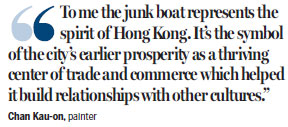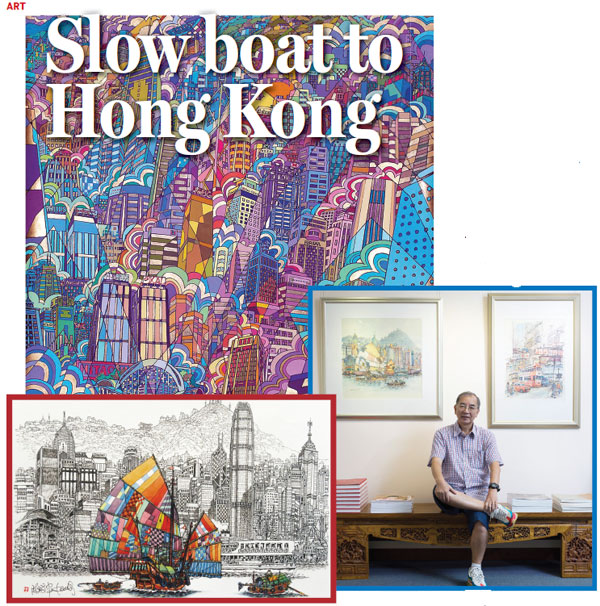Slow boat to Hong Kong
Updated: 2016-06-24 06:50
By Chitralekha Basu(HK Edition)
|
|||||||||
Even after 50 years of painting the city, Chan Kau-on shows no signs of wanting to move on. Chitralekha Basu met the landscape artist on the sidelines of his exhibition celebrating Hong Kong.
Chan Kau-on's watercolor urban landscapes of Hong Kong look like they're a throwback to the mod psychedelic images popular in the 60s - the sort that would appear on bellbottom trousers and music album covers (Yellow Submarine by The Beatles being one of the most-celebrated examples).
Chan himself, however, says he has never consciously followed a model, having found his signature style in the mid-1990s through years of diligent practice and the urge to evolve a personal idiom. Indeed, a close scrutiny of his best-seller paintings reveals a witty twist added to the city's waterfront scenery that is very original and very Hong Kong. In these watercolor landscapes - distinguished by the precise outlines and color blocking using rainbow shades at their most vibrant - hundreds of slanting oblong shapes have been used to select and highlight parts of the canvas. It's the artist's way of referencing a generic Hong Kong element - the traditional junk boat. The form of Chan's tilted oblongs cutting up and illuminating parts of the scenery, in which the iconic chrome and glass towers of the city's central business district are often conflated and made to fit into a single frame, is borrowed from the junk boat's distinctive partitioned sails.
"To me the junk boat represents the spirit of Hong Kong," says Chan. "It's the symbol of the city's earlier prosperity as a thriving center of trade and commerce which helped it build relationships with other cultures."
|
Chan Kau-on uses forms inspired by Hong Kong's generic junk boats in almost every landscape he paints. Roy Liu / China Daily |
Selected works from Chan's long and well-esteemed career (he had his first solo exhibition in 1966, four years after graduating from the Hong Kong Fine Art School) are now on show at Wan Fung Art Gallery in Central. Chan knew from the very outset that Hong Kong would be central to his artistic journey. Now after five decades of painting the city his fascination with it shows no signs of ebbing. "I have painted at least 50 images of the Victoria Harbour," says Chan. "It appears different to me each time I approach the theme, and each time I respond to it with a different set of emotions." He has painted the harbor front and the amazing cluster of singular structures and hills that form its backdrop in lines of ink, and again in quiet shades of charcoal and powder blue that is close to the Chinese literati tradition and also in warm vivid colors reminiscent of the Japanese Manga comics.

The junk boat leitmotif remains the art market's darling, spawning a cottage industry of copyists who reportedly charge in the region of HK$10 million to produce work that could be passed off as Chan's. Although one of Chan's collectors has sued such fraudsters, the artist himself remains relatively unruffled. "I understand plagiarists are doing it to earn a livelihood," says Chan, benignly. "But then my work is hard to copy. My technique is rather sophisticated, right from drawing, composition and application of color. It's hard to replicate even if you have watched me do it."
He is a little sad to think that he might be one of the last practitioners of manually-drawn landscape art in the city in the time of digital revolution and short attention spans. "In my young days I would go out during the day to sketch and take hundreds of pictures of the subject and stay up all night to work on the painting. Youngsters today prefer to do it all on the computer. Besides they have too many distractions in their lives these days," says Chan. "Also they seem to have the impression that my way of painting involves an extremely painstaking process. I can assure you it's not that hard, just takes a certain amount of diligent application."
Chronicler by default
There is no obvious trace of social awareness in his work. In fact his paintings could seem a bit too cheerful, exuding a vibe that is almost antithetical to the general tone of cynicism and despair prevalent in most forms of artistic expressions these days. Also, he does not seem to be doing much to break away from the template that has enjoyed a dedicated following in the market since he launched it 20 years ago.
"I don't mind being called old-fashioned," says Chan. "An artist's vocation is not necessarily about having to record every moment in history."
As someone who has been sketching the street scenes in Hong Kong for five decades, he could in fact have been performing the role of a pictorial chronicler of the city's history, even if it were by default. Chan smiles at the suggestion. He agrees a compilation of his sketches would make for a document of Hong Kong's eventful half a century. But then he did not set himself lofty goals such as raising awareness about the city's heritage when he started out, he says candidly. It was interesting to watch the tremendous changes the city was going through and be able to record some of these.
His ambition now is to be able to complete a quadriptych of large paintings (mixed media on acrylic) showing tonal variations of sunrise on the Hong Kong skyline before age catches up with him. But then he says working on a piece itself is the best tonic to keep him going. "Painting facilitates self-introspection, takes away life's anxieties and keeps my brain active. When I am at it I sometimes feel I have the energy of a 30-year-old."
Contact the writer at
basu@chinadailyhk.com
Dara Wang contributed to the story.
(HK Edition 06/24/2016 page6)
